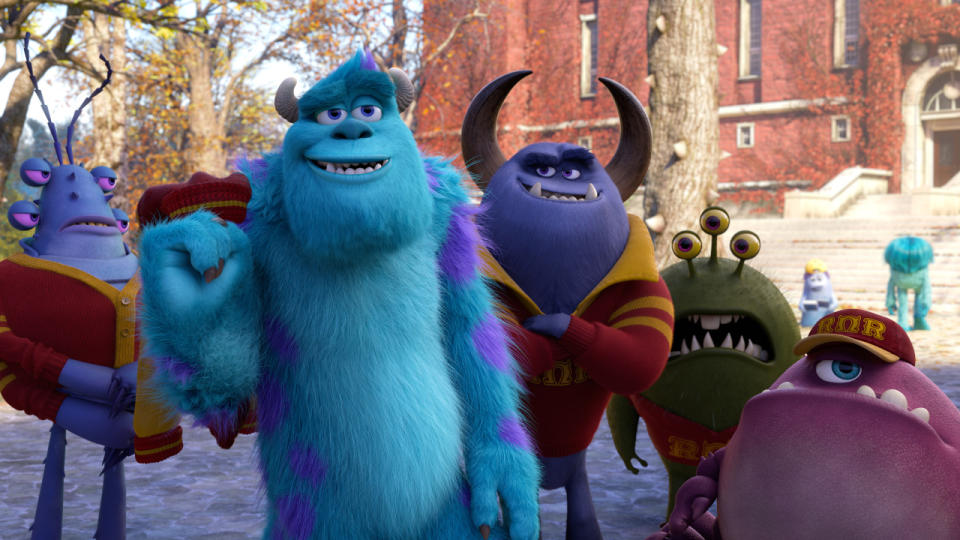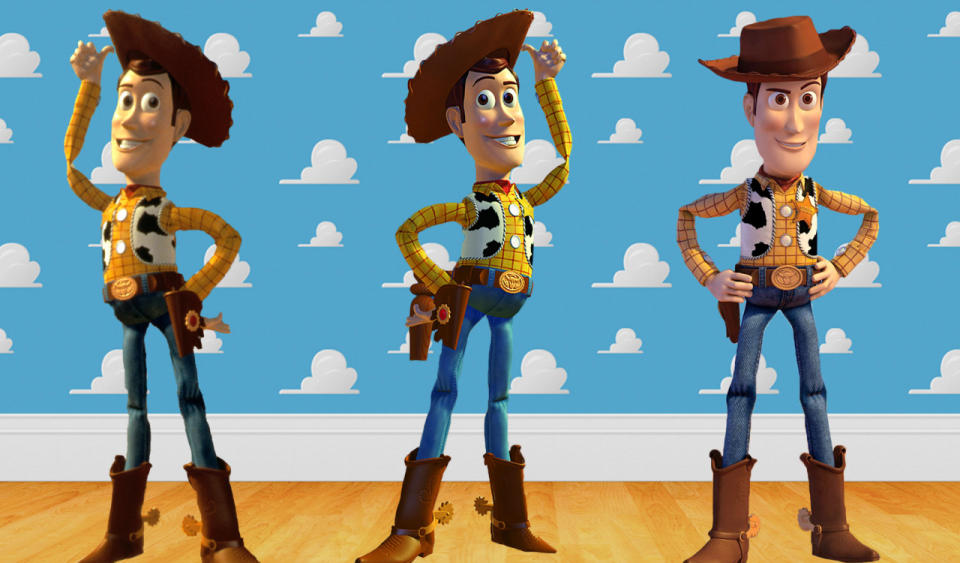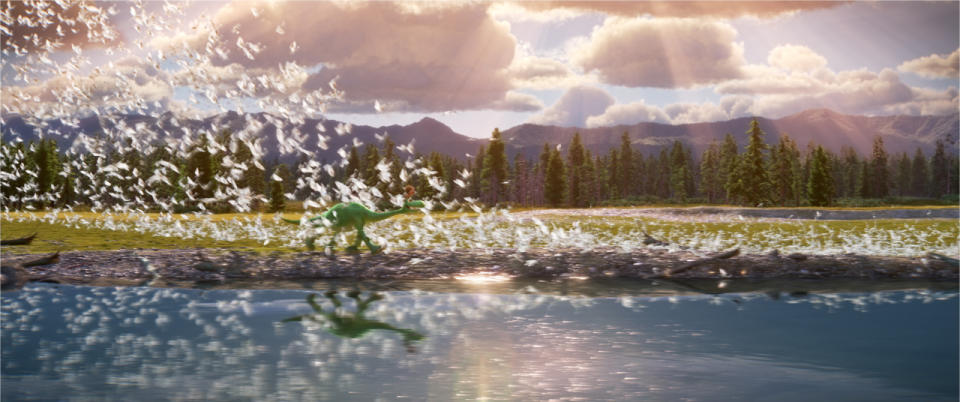Inside Pixar's Technological Evolution, From 'Toy Story' to 'The Good Dinosaur'

When Disney released a little animated film called Toy Story 20 years ago this month in 1995, audiences flocked to the theaters and made it the biggest film of that year. They were charmed by the delightful story of toys come to life. But they were also in awe of the groundbreaking new animation style. After 80 years of hand-drawn cartoons, a little-known company called Pixar had revolutionized the genre, introducing the first fully computer-animated film to the world.
While it was revolutionary then, Toy Story now wears its age on its plastic sleeve, thanks to the great leaps Pixar has made in its animation technology. This weekend’s new release, The Good Dinosaur, is Pixar’s 16th feature and boasts the most stunning animation yet, with breathtakingly realistic nature scenery: Its rivers, mountains, and individual blades of grass look so lifelike, you could almost mistake them for the real deal. Back when Toy Story hit theaters, few even at Pixar could have predicted The Good Dinosaur’s visual accomplishments.
“It’s no mistake that we made Toy Story first: It was a story filled with plastic and wood and glass — all the things that we could do with computers back then,” says Lee Unkrich, who has been a top creative at Pixar since Toy Story and directed Toy Story 3. “If you were to show us The Good Dinosaur 20 years ago and said, ‘This is the kind of movie you’re going to be making someday,’ we would be completely blown away.”
Yahoo Movies spoke with several longtime Pixar employees to look back on the company’s biggest innovations over the years, including the major leaps made for The Good Dinosaur. From Sulley’s blue fur to Mr. Incredible’s muscles, here’s what they had to say.

Photo: Disney/Pixar
Hair and fur in Monsters, Inc. (2001)
Before Monsters, Inc., Pixar’s characters in Toy Story, Toy Story 2, and A Bug’s Life were pointedly hairless. That’s because it was tough to create soft surfaces, let alone fur, given the sheer amount of computing power it took to create the many million little hairs; they also hadn’t cracked a way to use lighting to make those hairs look natural.
First and foremost, Pixar has been helped by the rapid increase in computing power over the last 20 years. More powerful computers allows its staff to create better effects more quickly, and faster rendering — the time it takes a computer to create a single frame — gives animators the ability to see a more realistic preview of their work as they’re animating it. The hit film about a pair of friendly monsters who scare little kids for a living, directed by Pete Docter, marked the first time that Pixar was able to render individual hairs and fur. The technological leap was necessary to create Sulley, the blue furry monster voiced by John Goodman.

“I look back on Toy Story, if we had to do blonde hair it was a disaster because we couldn’t properly shadow it to make it not have an ugly color or be glowing super bright,” says Sharon Calahan, Pixar’s celebrated director of photography.
Part of the solution was something called “deep shadow maps,” which record the amount of light that should reach each layer of fur or hair. A great example is below: The hair on the right is flat, lifeless, and synthetic-looking. On the left, we have hair rendered with the deep shadow map technology, which created realistic shadows and richer textures on the character’s mane.

An example from a 2000 Pixar paper on deep shadow maps (Disney/Pixar)
Sulley’s body had more than 3 million hairs that each had to be able to move independently, but also logically — like, say, how our own hair would react when brushed or blown by the wind. Even a monster’s fur gets ruffled by the elements.
By the time the prequel, Monsters University, hit theaters in 2013, the computer processors were powerful enough to render previews of the picture they were creating closer to real time, and audiences can see the difference. Sulley’s hair is a much richer color, with more realistic shadows, thanks to the animators’ ability to see it earlier and make the proper adjustments.

Photo: Disney/Pixar
“The difference between [Sulley] in Monsters, Inc. and Monsters University is his fur really changes his silhouette and the volume of him as a character,” Mike Venturini, a supervising animator at Pixar, explained. “On Monsters, Inc., we didn’t see the fur until after we were done animating; that’s when they rendered the fur. Now the computers are so much faster that they can generate fur faster, so we have temp fur that’s a guide to what it’s going to look like and we can see while we’re animating it. It helps us make better choices.”

Photo: Disney/Pixar
Water in Finding Nemo (2003)
For Pixar’s first foray underwater, director Andrew Stanton and Co. had to figure out just how to create realistic-looking water — one of the hardest things to make in computer animation.
Unlike air, which is marked by the absence of elements, water is chock full of different variables, from dirt to bent light to the constant motion of the tide. Plus, there’s the exaggerated ways that things move underwater, where you can always see the ripple effect of every change.
“The underwater part was largely faked in compositing,” Calahan said. “It was layers and layers of fog and murk and particulate — the kind of stuff that told you that you were in an underwater environment.”
From the bubbles that float to the surface to the dirt that dances around the vegetation on the ocean floor, it’s the little details that give the impression that the little fish are making their way through a real physical environment.
Watch a scene from ‘Finding Nemo’ below:
Water continued to advance over the next few films, including Brave, which saw several big environmental improvements. Liquid also played a surprisingly large role in 2007’s Ratatouille, because the production had to figure out how to simulate so many different kinds of fluids during all of the cooking scenes in that Paris-set rodent fairy tale.
The Good Dinosaur and next year’s Nemo sequel, Finding Dory, represent major new leaps for the animation of water. The rapids in The Good Dinosaur rage and reflect the wide-open sky in ways Pixar animators couldn’t have dreamed of during the production of Finding Nemo.
“We’re constantly upgrading our water surface shader, all the elements that go into making water look good,” Calahan says. “When you look at the water surface in Finding Nemo, it looks pretty plastic-y. We didn’t have all the aeration and foam and all the stuff that makes it feel like it has more detail to it.”

Photo: Disney/Pixar
Humans in The Incredibles (2004)
While Monsters, Inc. and Finding Nemo had some humans in them, the 2004 hit The Incredibles, directed by Brad Bird, marked the studio’s first full feature about human characters. As it had with fish and insects, Pixar opted to make the humans cartoonish instead of photorealistic. Just about every attempt to create believable CGI humans ends up more creepy than convincing because audiences are so intimately familiar with human faces. It’s a principle known as the “uncanny valley,” and you can see it in action most famously in Robert Zemeckis’s 2004 Christmas film, The Polar Express, which starred an off-putting digital version of Tom Hanks.
Yet Pixar still had to make the heroes of The Incredibles look believably human, which required realistic muscles, fat, movement, and skin. The key to getting to that point was a whole lot more control of the characters’ individual features, which was where the rigging team came in. They build the character models and install all the different controls inside them, which allows animators to manipulate different parts of their faces and bodies.
On average, there are about 1,000 to 1,500 controls in each character. “If you think of it like puppeteering, we need little strings to pull for every piece of movement we want to do on a character,” Venturini explained. “We got really specific in The Incredibles with the type of facial controls, specifically in the eyes and eyebrows, to get different shapes.”
Human skin, meanwhile, required more subtle detail than the surfaces of a bug, a wooden toy, or a fish. “A lot of the key components were getting the subsurface [of the face] to be there,” Calahan said. “Like in Toy Story, we had no subsurface shading. We’ve had that for a while now … Some of it is just really subtle surface detail, like the peach fuzz you get from the subtle hairs on your skin.”

Photo: Disney/Pixar
Curly hair in Brave (2012)
While they first cracked hair for Monsters, Inc., it was 2012’s Brave that broke important new stylistic ground: It was the first film to really nail curly hair, which is even harder to create onscreen than it is to manage in real life.
For starters, while curly hair straightens under intense force (like, say, wind) in the real world, animators wanted to keep the Scottish heroine Merida’s curly red mane coiled up even after it bounced and stretched a bit during action sequences. They created layers of curls and piled them on top of one another, as you can see in the illustration below.
In total, there were 1,500 individual curls, which in turn represented lots of other hairs that were coiled around them. To make the hair move, they used a system called “core curve and points,” which allows hair to move, but only so much. It took three years to get the hair just right.

A timeline of the layers of curls built for Merida’s hair (Disney/Pixar)
Brave was a major benchmark for Pixar. Unkrich describes the Oscar-winning film as the moment when all of the studio’s individual tech accomplishments came together in one production.
“Brave had great water in it and fur and great-looking humans and vegetation that kind of showcased everything that used to be really challenging,” Unkrich says. “Once we made a movie like that, I don’t know there’s any holy grail beyond that anymore.”

The Evolution of Toy Story
Audiences’ minds were blown when Toy Story first hit theaters, but the animators and technicians at Pixar knew that, given the chance, they could make its characters look even better. They got their first shot in 1999 when Toy Story 2 came out, and then were really able to show off their new capabilities when the third chapter in the beloved saga was pegged for release in 2010.
The animation of Toy Story 3 was an interesting challenge for Pixar because it had to strike a balance between having the animation up to its new standards and not alienating longtime fans with new renditions of their favorite characters.
“We did a lot of analysis of the earlier films and the style of lighting and the design language, and we made sure we stuck to that,” says Unkrich, who directed that third film. “But we really upgraded the characters to have a lot more detail than they’d ever had, and made them much more real.”
Above, you can see the evolution of Woody and the small, but noticeable improvements: His shirt is a deeper yellow, his skin more naturally flush, and his pants seem more obviously made of thread. Woody looks more alive in the third photo, even though he’s still a plastic toy.
“We’ve gotten really, really detailed with the amount of controls we have in an eye, and with Toy Story 3, we had to simplify our eyes back toward what we were doing before to keep them feeling toylike,” Venturini says. “If you see Woody on the screen, there’s a tactile feel to the cloth he’s made out of. You can actually see and feel the threads, where before it was a very simple shader that was used because we didn’t have the technology to do such high-level detail.”

Photo: Disney/Pixar
Mother Nature in The Good Dinosaur (2015)
Delayed a year as they reorganized the story and let new director Pete Sohn take command of the project, The Good Dinosaur was worth the wait. About a young dinosaur trying to find his way home after being swept up in a raging river, it is the most visually striking of all the Pixar films, thanks to several new or vastly upgraded approaches to set design. Among the most striking new details: sumptuous new clouds.
Related: The Making of ‘The Good Dinosaur,’ Frame by Frame
“What’s awesome about that is it allows the lighting department to filter sunlight through the clouds,” Venturini said, noting that they created the new “volumetric” clouds using clumps of data that makes 3D objects. “You can see the shadow of the cloud going overhead, and you can diffuse light to get that overcast look. Those things we weren’t able to do before. And it’s one of the reasons you were able to say this world feels so rich and lush.”
Calahan, who worked extensively with the clouds and light as the director of photography, said it was a huge step up from past attempts to light large areas. And it helped believably light the huge terrain that they had to create, given the scope of the film and size of its characters.

To create that vast landscape, Pixar for the first time used data from the U.S. Geological Survey, downloading more than 65,000 miles of satellite information. “The sets department got those maps where it shows all the elevation ranges,” Venturini said. “They were able to plug that into the computer and auto-generate terrain, so they could rapidly build mountain ranges.”

“In this film, there’s no matte paintings,” he added, referring to the background paintings usually used in animation (and many old science-fiction films). “When you see the world go on forever, normally you’d use a matte painting; but because it goes on forever, you can use all these camera movements and make the world feel huge.”

